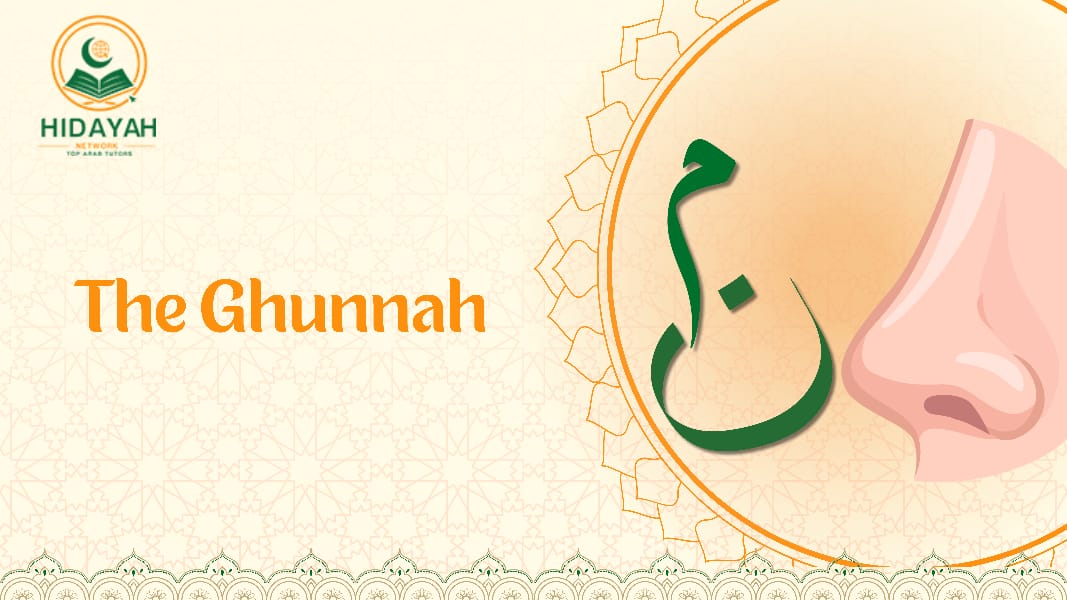Tajweed rules are a lot and very important in reciting Qura’n. It guides us to ensure the accurate and true pronunciation of Quranic Ayahs. It makes the reciter of Qura’n more proficient and confident when he observes the correct pronunciation of each letter.
As the prophet (Peace Be Upon Him) said: “The one who is proficient in the recitation of the Quran will be with the honorable and obedient scribes (angels) and he who recites the Quran and finds it difficult to recite, doing his best to recite it in the best way possible, will have two rewards.”
.”الذي يقرأ القرآن وهو ماهر به مع السفرة الكرام البررة، والذي يقرأ القرآن ويتتعتع فيه وهو عليه شاق له أجران”
(Al-Bukhari and Muslim)
So the application of these rules is very necessary and important. One of these important rules is Ghunnah. You may wondering if it is just a definition or sound we should know it or how to apply this rule?. In this article, you will know all about Ghunnah, will answer all the questions are in your mind and help you to recite Qura’n accurately.
What is Ghunnah?
Ghunnah linguistically is an Arabic term that literally translates to “nasal sound” or “nasality.” In the context of Qur’anic recitation, it refers to a specific nasal sound produced when certain letters are pronounced in a particular way.
This sound is produced by the vibrations that occur in the nasal cavity when air passes through the nose while the mouth is closed.
Practically, The Ghunnah is a characteristic feature of certain letters in Arabic, particularly those that are pronounced with a nasal resonance.
It is essential to accurately pronounce these sounds to ensure the correct recitation of the Qur’an. Knowing how and when to produce this sound is essential in order to read the Quran with tajweed rules correctly.
What are Ghunnah Letters?
There are specific letters in the Arabic alphabet that require the Ghunnah sound. These include:
م (Meem) – The letter meem is pronounced with a nasal sound when it is accompanied by Ghunnah.
ن (Noon) – Similar to meem, the letter noon is also pronounced with a nasal quality when recited with Ghunnah.
و (Waw) – In certain cases, the letter waw may also carry a nasal sound.
ي (Ya) – The letter ya can also involve a nasalization in some instances.
Additionally, Ghunnah plays a vital role when certain rules of Tajweed are applied, such as Ikhfa’ (concealment) or Idgham (assimilation). Understanding how and when Ghunnah should be used can greatly enhance the beauty and accuracy of the recitation.
The strongest Ghunnah is present in letters ن and م and also the extreme degree whenever these two letters are with shadda.
If you don’t know the meaning of shadda, it is a vital diacritical mark in Arabic that doubles as a consonant, merging two symmetrical sounds, one is sakin and the other is a vowel for precise pronunciation and meaning.
The certain letters that Ghunnah is applied for are letters in Arabic are ن and م, where ن (noon) includes a tanween.
Types Of Ghunnah
We can present types of Ghunnah in two different classification ways, the first is classified into five types:
- Ghunnah in the Letters: This is the nasal sound produced by the letters ن (noon) and م (meem).
- Ghunnah in Idgham (Assimilation): Occurs when a letter with ghunnah merges with another letter, requiring continuation or absence of ghunnah, depending on the type of assimilation.
- Ghunnah in Ikhfa’ (Concealment): The noon sound is concealed when followed by certain letters, but the nasal resonance continues.
- Ghunnah in Iqlab (Conversion): When noon is followed by ba, the noon converts to a meem sound, and the ghunnah continues.
- Ghunnah in Tanween (Nunation): The nasal sound is produced at the end of words with tanween.
The second way, classified into four types depending on their level.
- Most Complete (أكمل) – The first longest type of Ghunna, found in ن and م with Shadda over them or in idghaam rule with Ghunnah if one of these letters (ن م ي و) is preceded by a noon Sakinah or a tanween.
- Complete (كاملة) – The second longest Ghunna found in Al-Ikhfaa’ Alhaqiqi, Al-Ikhfaa’ Ash-Shafawi, and Al-Iqlab.When the noon saakinah or meem saakinah are followed by one of the letters of ikhfa’ the ghunnah that results from this ikhfa’ is the complete in its timing, but not as long as the most complete ghunnah.
- Incomplete (ناقصة) – The other name of this type is “short Ghunna”, it is shorter in duration than the complete type. This type is found when we recite ن and م (with Sukoon over it) with Izhar.
- Most Incomplete (أنقص) – This type is the shortest of all found when reciting the ن and م with vowels. You can differentiate between these degrees is the duration of these types of Ghunna, and this difference in duration is minimum.
Now, you must be crucial about the duration of Ghunnah and how long it should be?
The Duration of Ghunnah in Qur’anic Recitation
The concept of Ghunnah is not only about producing a nasal sound but also about the duration for which that sound is held during recitation.
The correct duration of Ghunnah is a critical aspect of Tajweed, as it ensures the proper articulation of words and maintains the sacredness and melody of the Qur’anic recitation. In this section, we will discuss the duration of Ghunnah, how it is measured, and why it is important.
How Long Should Ghunnah Last?
The duration of Ghunnah is typically prescribed as two counts or two beats. This duration is a standard measurement in Tajweed and is referred to as a “Madd” or elongation. It is not a random or arbitrary duration but one that has been carefully passed down through Islamic scholarship.
1. Standard Duration:
The general rule is that ghunnah should last for two counts (also referred to as al-madd al-wajib). This is similar to other elongations in Tajweed, where sounds like madd (elongation) are held for a specified duration to give the recitation its proper rhythm.
2. How to Count the Duration:
The count for Ghunnah typically follows the rhythm of the recitation. Each “count” is essentially one beat, and it is commonly counted like this: “one… two.” It’s important that the reciter doesn’t rush through the sound, as this will undermine the nasal resonance that defines ghunnah. Likewise, the sound shouldn’t be held too long, as this would distort the balance of the recitation.
3. When Does Ghunnah Occur?
The ghunnah sound occurs when certain letters in the Arabic alphabet (such as noon and meem) are either nasalized or when they occur in specific Tajweed rules such as idgham (assimilation) and ikhfa’ (concealment). For instance, when noon or meem is followed by a letter that requires ghunnah, the nasal sound should be pronounced for two counts.
Examples of Ghunnah from Quran
Some of the many examples of ghunnah from Quran in Arabic are as follows:
{قَالَ عِفْرِيتٌۭ مِّنَ ٱلْجِنِّ أَنَا۠ ءَاتِيكَ بِهِۦ}: [Surah An-Naml: 38]
The meem after the tanween in “عِفْرِيتٌۭ مِّنَ”
{فَمَن كَانَ يَرْجُوا۟ لِقَآءَ رَبِّهِۦ فَلْيَعْمَلْ عَمَلًۭا صَـٰلِحًۭا}: [Surah Al-Kahf: 110]
The kaf after noon sakinah in “فَمَن كَانَ” (Ikhfaa)
{بَلْ أَنتُمْ قَوْمٌۭ مُّسْرِفُونَ}: [Surah Yasin: 19]
The shadda of meem in “قَوْمٌۭ مُّسْرِفُونَ”.
{يَنقَلِبْ إِلَيْكَ ٱلْبَصَرُ خَاسِئًۭا وَهُوَ حَسِيرٌۭ}: [Surah Al-Mulk: 4]
The qaf after noon sakinah in “ينقلب” and waw after tanween in “خَاسِئًۭا وَهُوَ”
{وَأَنفِقُوا مِمَّا جَعَلَكُم مُّسْتَخْلَفِينَ فِيهِ ۖ }: [Surah Al-Hadid: 7]
Ghunnah in “مِمَّا” shadda in meem.
Idghaam with Ghunnah Examples
The Idghaam of Noon Sakinah and Tanween is one of the most important Tajweed rules that we all have to recite the Quran with. There are two types of Idghaam.
The first one that we are going to cover in this post is Idgham with Ghunnah. This happens when any of these letters (ي، ن، م، و) follows Noon Sakinah or Tanween.
Their joining with Ghunnah letters happens in two groups. The first one is Full Idghaam – it indicates that the humming is quite powerful than it would be if the lesser one was generated. These letters (ن، م) are mostly used with. The second one is sounded for two counts, like the regular time it takes to say the words “one-two” usually.
How should we practice the Ghunnah?
Here are some exercises to solidify your Ghunnah pronunciation:
- Separate the Sound Of it: Start by practicing the Ghunnah sound alone. Try humming while closing your mouth to feel the nasal vibration.
- Concentrate on Individual Letters: try to pronounce Noon and Meem with a Shadda, extending the duration of nasalization for the prescribed.
- Then you can move on to Words: Once you have to be comfortable with isolated letters, practice words with Ghunnah, like “مَن” (Man) and “نِعْمَة” (Ni’mah).
- Finally try Quranic Verses: Include Ghunnah practice into your recitation routine of Quran.
Tips for Perfecting Ghunnah in Your Recitation
Five technical tips can help you to improve your recitation:
- Practice with a Teacher: One of the best ways to perfect Ghunnah is to learn from a qualified teacher who can provide feedback on your pronunciation and help you make the necessary adjustments.
- Listen to Skilled Reciters: Listening to skilled reciters can help you familiarize yourself with the correct sounds and intonations. You can find many beautiful Qur’anic recitations online, from famous reciters such as Sheikh Sudais, Sheikh Shuraim, and others.
- Record and Review Your Recitation: Recording yourself while reciting the Qur’an and listening back can help you identify areas where your Ghunnah may need improvement.
- Consistency: Like any skill, the key to mastering Ghunnah is consistent practice. By regularly practicing the correct pronunciation of Ghunnah-related letters, you will gradually improve.
- Search for online facilities: there are many websites and platforms that can help you easily like Hidayah academy
Conclusion paragraph
After this article we have presented the applications of the Ghunnah rules, the sound of it and how to practice it. Now, you can know the informational and practical tips about Ghunnah which make you perfect in recitation Qura’n. As it offers accurate pronunciation, enhances your recitation skills and preserves linguistic beauty.
Finally, we should be aware of how these rules preserve the Quran’s message, facilitating accurate memorization. Tajweed fulfills the Sunnah of the Prophet Muhammad ﷺ, who emphasized precise recitation of the Quran.

About Author

